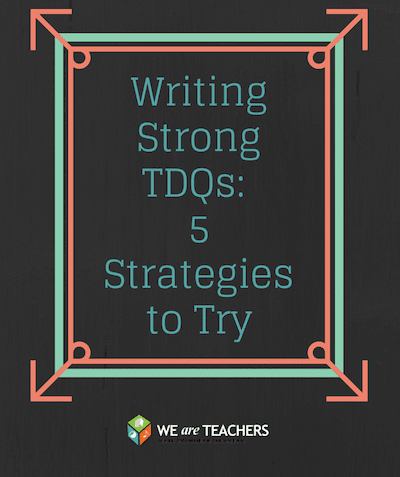This is the third in a three-post series about TDQs. Read the other two posts here and here.
We’ve covered the basics about close reading and text-dependent questions in our previous posts. Now it’s time to up our TDQ game: How can we come up with good TDQs to use again and again? Here are five question-planning strategies to try:
1. Build a Bank
As you build close reading lessons, you’ll return to the same texts year after year, the same genre of text multiple times throughout the year, and you’ll want to use TDQs to elicit the same type of information from students lesson after lesson.
Create a chart of the types of TDQs you use often so you can tailor each to the text at hand. For example, questions about fiction structure:
- What do you learn about the setting? What information does the author give you?
- How do the characters in the story react to the setting?
- What do the characters say? What does that reveal about them?
And questions about nonfiction text features:
- What text structures does the author use? Were these good choices? Why or why not?
- What new information did you learn from this caption? How did the information in the captions add to the information in the passage?
(Find more TDQ examples here).
2. Scaffold TDQs
When TDQs start small—focused on details—and build to extract larger meanings and understandings, you’re scaffolding the student experience. For example,
- Start with a question about the character: What do you learn about the character in this scene?
- Then, build to a question about narrative development: How does the main character treat other characters in this scene? Is this “in character” for this character, why or why not?
- And, finally, ask questions about theme: How do the character’s actions support the theme of freedom? What does the author reveal about freedom through the character?

3. Have Students Create TDQs
Eventually, you want students to be able to ask questions of text that go beyond “what happens next?” When they can write TDQs, they can drive their own experience with and discussion of text. To do this, have students find information or
ideas in the text that they want to talk about. Then, have them write questions that send their peers to those sections of text.
4. Use TDQs to Tackle Differentiation
Identify the parts of the text that are most challenging, or that will challenge specific groups of students. Then, plan questions to help students master those portions of text. For example, if a small group needs support around vocabulary, plan additional
questions to help them define key words from the text. (Check out this Colorin Colorado blog post for ideas relating to TDQs and ELLs in particular.)
5. Use TDQs to Tackle What’s Not There
Once students are familiar with how to answer basic TDQs, have them think beyond the text to the options, information, and features that the author did not include. This creates pairs of TDQs, for example:
- TDQ: What information does the author reveal about the setting in the first paragraphs? And non-TDQ: What information is not revealed? Why not?
- TDQ: What details were included in the passage? And non-TDQ: Why might the author choose to include the details he did? What details weren’t included and why didn’t he include those?
We want to hear your TDQ success stories! How have you used TDQs in your classroom?
Samantha Cleaver is a former special education teacher, current education writer. Her book about close reading, Every Reader, a Close Reader, is coming out this summer from Rowman and Littlefield. Read more at her blog: www.cleaveronreading.wordpress.com.

